There’s no magic formula to success on YouTube. However, various pieces work together to signal to YouTube that you and your content are worth promoting and surfacing to the billions of viewers each month.
One important area to monitor is your YouTube subscriber count. Although increasing your subscriber count may feel overwhelming, the effort is worthwhile for you and your future audience.
This guide will explore some key reasons why subscribers still matter and try to debunk some myths about the YouTube algorithm.
Keep in mind a few things:
- YouTube and your channel generally benefit when you get viewers to subscribe.
- Subscribership signals credibility to new potential subscribers and viewers about the trustworthiness of your content, which can help overall viewers and engagement.
- Subscriber count was a significant indicator of success (hello, silver, and gold play buttons!), but it’s not a central indicator of overall success.
Why YouTube subscribers matter
Even though subscribers aren’t the number one leading indicator of success, they are still important.
First, various YouTube programs, like their Partnership Program, require a minimum of 1,000 subscribers.
Second, a growing subscriber base means you have more viewers to share your video with every time you publish. These YouTube users are interested in having your content served to them. They’ve asked to see it, which can help increase views and engagement, which are crucial to a successful channel.
Third, good subscriber numbers indicate that you are trusted and that people want to watch your content. If you rely on channel subscriber numbers, you will likely find some potential pitfalls. However, don’t ignore the benefit of growing your channel’s subscribers.
Optimize your YouTube channel for growth
Suppose you want to grow your channel, including gaining more subscribers on YouTube. There are a few ways to optimize your channel.
Craft a compelling channel description
One of the opportunities to help your channel’s success is to write a compelling yet concise channel description. Your description should give both your viewers and YouTube a clear understanding of what your channel is about.
To do this well, you need to understand who you are trying to reach and the focus of your channel. For instance, are you focused on workplace productivity, gaming, or something else?
You may not be entirely sure, and you can adjust later, but having a focus will help your channel be found by those looking for it and help YouTube know who to show it to.
As you write, include relevant keywords in your description. This YouTube SEO best practice will help clarify what your channel is about. Keywords will also help your channel appear in YouTube and Google searches.
As you write, you should avoid keyword stuffing or adding keywords just to be found. This can have adverse effects and may cause your channel not to be found.
If you have to choose, go for concise and focused, and add information that helps set you apart.
Create eye-catching channel art and thumbnails
Another way to optimize your channel for growth is to create compelling channel art and thumbnails that catch viewers’ attention.
Channel art provides an opportunity for unique expression and branding of your channel. This can help further indicate to your viewers what your channel is about. It should be related to and in support of your channel description.
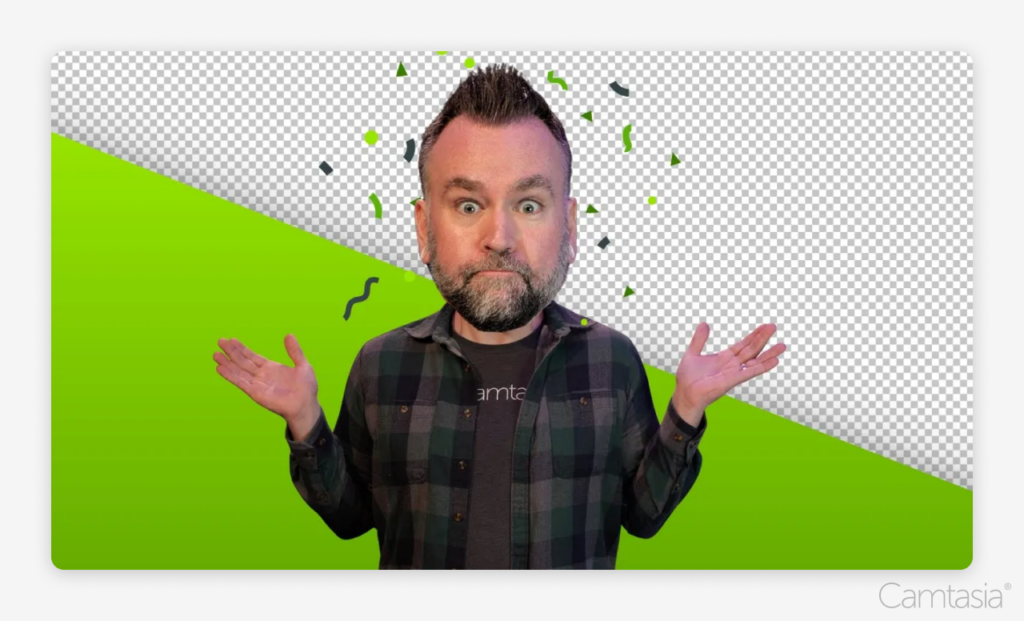
Some creators will use the channel art as an opportunity to provide more content, information, and, of course, a sense of personality, which will encourage viewers to become and stay subscribers.
Video thumbnails are gateways to attracting viewers to your videos. As viewers scroll through YouTube, most likely, the first thing they see is video thumbnails. Yours must stand out.
Thumbnails can also help you establish and maintain your overall brand. While a viewer might not watch the first video or their third video from you, having a style that ties them together is helpful. If they see one they like, maybe they’ll watch another.
Or if they see multiple videos from you, they might realize you have a good amount of content and that they are worth checking out.
Numerous tools can help create a successful YouTube video. Regardless of the tool you use, we recommend taking a photo of yourself or the person who will be on screen either while recording or just after. Use these images as part of your thumbnail.
Need to grab a unique image? Or are you working with screen content or other types of content?
Grab a frame from your video editor. For instance, TechSmith Camtasia can save the frame of an image, which can then be further edited or used for your thumbnail. This is a great way to represent and show what your content is about accurately.
Produce high-quality, consistent content
Growing your channel requires more than a good description and catchy graphics; it also requires consistently creating high-quality content.
Focus on video quality and production
In the recent 2024 Video Viewer Trends Report, which surveyed 1000 individuals about their preferences for informational and instructional videos, most respondents reported that “clear audio and clear video footage” were the most critical aspects of videos to keep viewers interested.
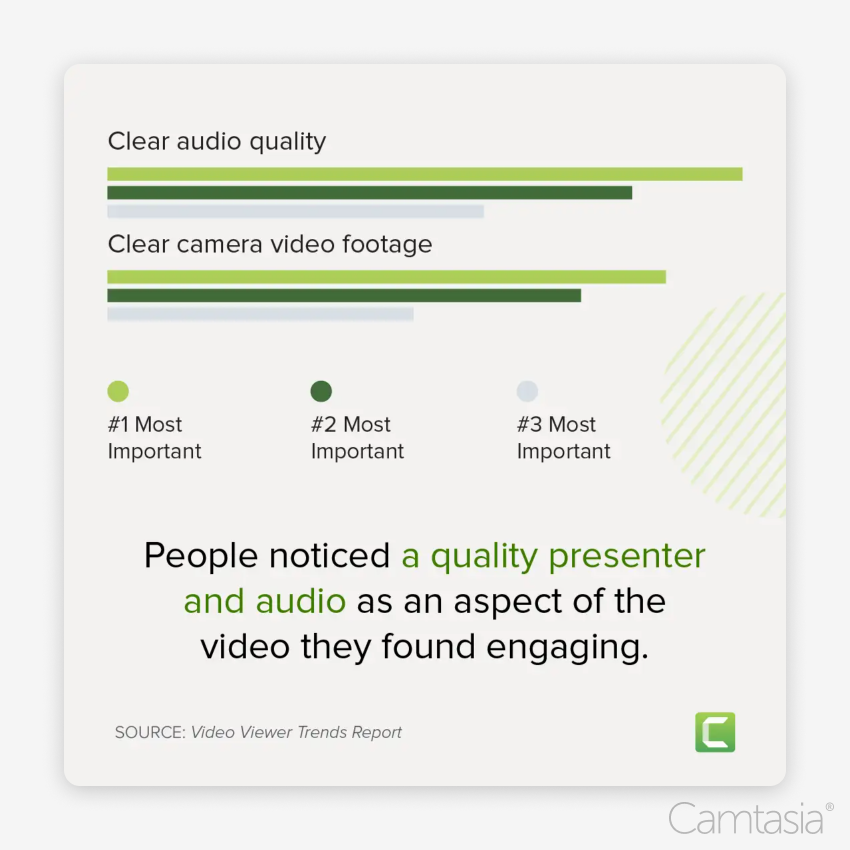
Audio and visual quality are just a few attributes of what makes a high-quality video.
A major reason people stop watching is that they feel the video isn’t relevant. As you create your videos, make sure they align with your title and descriptions.
What you show in your video matters. Your viewers want to see content that fits and isn’t static or boring. You’ll need to find ways to enhance your videos.
One of the simplest is to keep things changing and moving. This could be cuts, pans, or other on-screen elements.
If you want to create high-quality, engaging videos, check out TechSmith Camtasia. Camtasia allows you to capture your screen clearly and edit your video to engage your viewers. For instance, with screen recordings, you can enhance your mouse cursor by changing its size, adding effects, and even adjusting your cursor path.
Camtasia also allows you to add annotations, animate objects on your screen, remove the background from your camera video, and much more. Using these effects and others, you can create engaging and interesting content that will keep your viewers watching.
Stick to a consistent upload schedule
As you launch your channel and aim to grow, setting up and sticking to a consistent schedule is essential. This doesn’t mean you have to publish a video daily or every week, but you do need to carefully consider your schedule. Once you establish it, try to stick to it.
Being consistent is challenging.
However, consistency is a promise to your target audience. That consistency will also keep you at the forefront of your viewers’ minds, bringing them back to visit your YouTube channel.
YouTube seems to favor channels that publish regularly and consistently. Too infrequent or erratic posting makes it hard for viewers to tune in or even to know when to expect a new video. This can lead viewers to forget to watch or find another channel with the information they need.
Feel free to explore different options if you aren’t sure what your schedule should look like, but try not to change it too often or too soon.
Experiment frequently and with purpose. You may find that certain days and specific times of day perform better. Use this data to help you refine and adjust your decisions.
Ultimately, your publishing schedule is a balance between serving your audience’s viewing habits and what you can realistically and sustainably stick to. If you have to pick one over the other, for most things, the audience wins. However, in this case, your ability to publish with the quality and impact you want should be the priority.
Don’t worry about being perfect, but hold to that schedule.
Amy Landino, creator and author of Good Morning, Good Life, emphasizes that striving for perfection often hinders consistency.
She notes that creators delay starting because they feel unprepared or lack the right resources.
Even after beginning, they may become overwhelmed by the effort required to produce and repurpose content, making consistency the most challenging aspect.
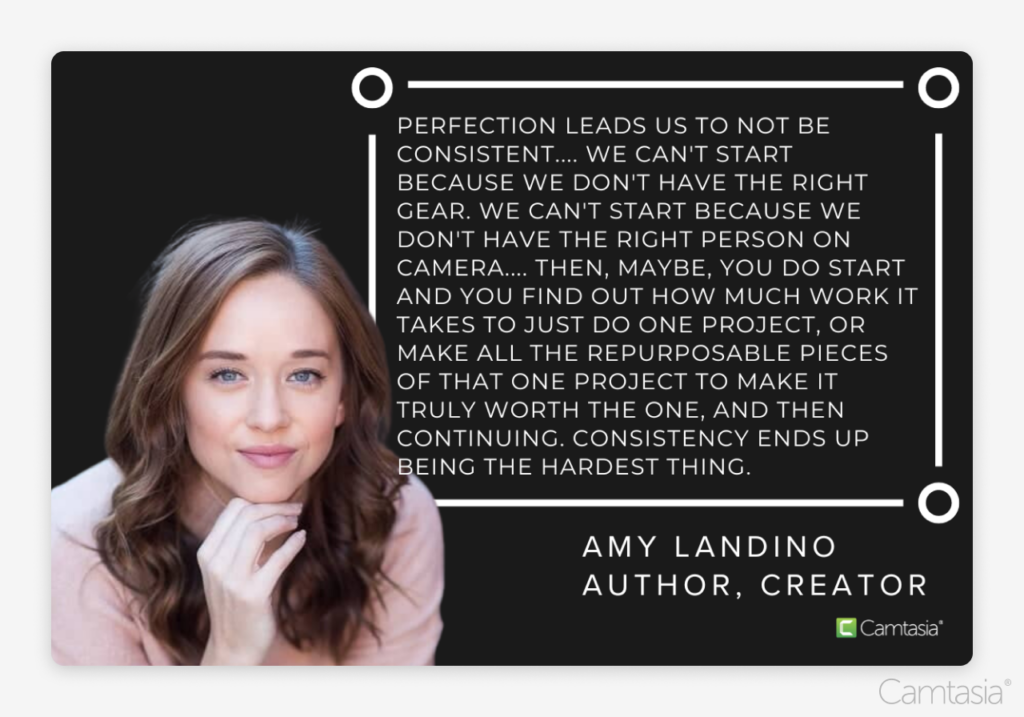
Leverage YouTube SEO to boost discoverability
As much as the content in your video matters, the content around your videos on YouTube matters as well. Understanding a little about Search Engine Optimization (SEO) for your content can go a long way in helping it be discovered.
Perform keyword research for YouTube searches
YouTube has billions of videos and tons of competition, but many people are also searching for content.
This means you need to both stand out and understand what people are looking for. If you can align with these opportunities, you’ll be on your way to having YouTube and Google bring your videos up in the search results.
First, you’ll need to understand what people are looking for and the words they use to search for a particular topic.
A simple first step to finding this is opening YouTube in your browser and conducting searches.
For example, let’s say you are interested in teaching people about freezer meals: the benefits, savings, and how to make them. On YouTube, search for the keywords ‘freezer meals.’
What do you find? What videos show?
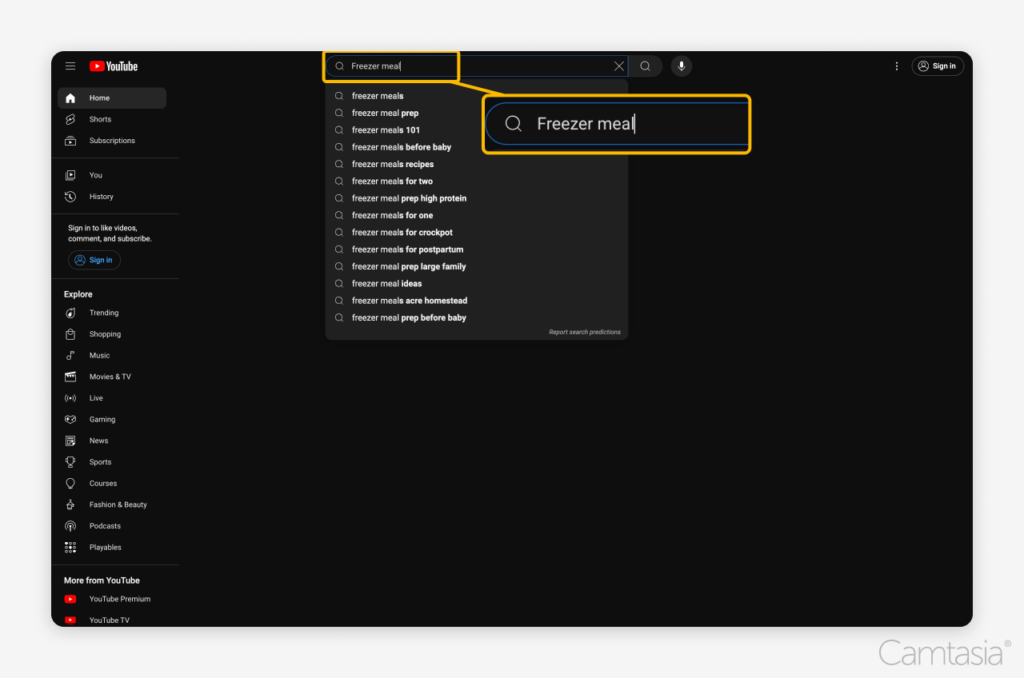
Are the videos that appear in the search surprising? Are they using any words or phrases that you could work into your content?
The next step is to take that same phrase, “freezer meal,” hit the space button, then the letter ‘a’—YouTube or Google’s autofill will show you a list of items that are searched for.
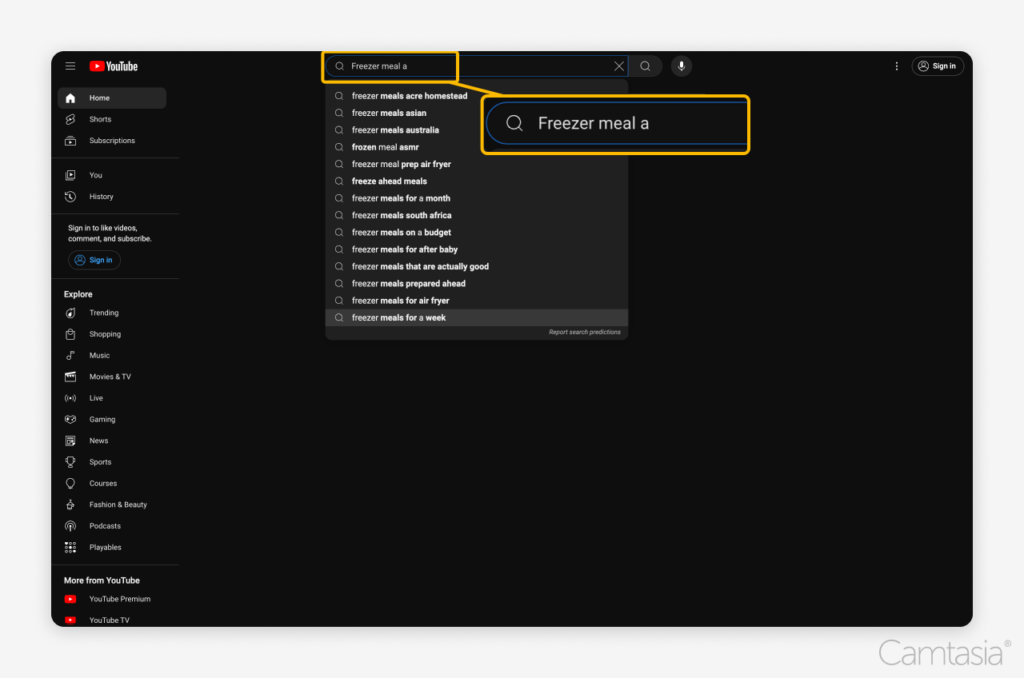
Write or screenshot the options that fit your niche and make sense for your channel. Then, repeat this process for the other letters of the alphabet.
As you go through this process, you want to note keywords and phrases that are being used. These will become important to work into your video titles, video descriptions, scripts, or conversations. These keywords help YouTube determine whether to show your video to someone searching for a specific term.
One shortcoming of using YouTube’s auto-complete to gain keywords is that the amount of information about each keyword is limited. Other available tools can help you understand how many people search for specific phrases. They can also tell you if there are related keywords.
Tools like VidIQ, Tubebuddy, SEMRush, Moz, and Ask the Public have suites of sophisticated tools to help conduct SEO research. These can be extremely helpful as you narrow in on your niche topics and find ways to integrate keywords and phrases to help your content rise to the top of search results and be more likely to be presented on YouTube.
Optimize video titles, descriptions, and tags
As you look to optimize your surrounding content, you first need to make sure that the video you created fits with the keywords you’ve chosen. If your keyword is ‘Freezer Meals Fast’ and your video is a reaction video about a new Gordon Ramsey recipe, it doesn’t help you, your channel, or the viewers of the video.
Your keywords and your content need to be aligned.
Using that same example, we might need to make our title specific so our viewers know what the video is about and why they should watch it. For example, ‘How to Make 3 Freezer Meals Fast – 20 minutes or less each’ could be a good title.
Work to ensure that anyone searching knows exactly what they will get.
That same video should also have a description. YouTube descriptions can have up to 5000 characters. You don’t have to use all of them, but longer descriptions provide more opportunities to use your keywords and give context and additional information about your video.
Best practice suggests using your keyword two to three times in your description.
Remember that most of your description will not be visible without a click. Typically, only about the first 25-30 words are visible. Use your first sentence, about 50 to 100 characters, to highlight the benefit a viewer will get from your video.
As you integrate keywords and conduct SEO research, do not just fill your titles, descriptions, and tags with keywords. Keyword stuffing, if detected, may cause YouTube to deprioritize showing your content. Use your keywords responsibly and appropriately, and you’ll be fine.
SEO is important to help your video be found, but remember that numerous factors can impact whether your video is viewed and found. However, good SEO will put your videos and your channels on a good footing and make them more likely to be found.
Use the YouTube algorithm to your advantage
The ever-present but mysterious algorithm is the key to being found and having video success. But what the algorithm uses to make its decisions isn’t publicly known. That doesn’t mean we can’t work with it to help give you the best opportunities for success.
Understand how the YouTube algorithm works
One of the most important concepts about the YouTube algorithm is that it has one main job: helping viewers find what they want to watch and then continuing to provide them with relevant options.
That’s its whole job.
From a creator’s perspective, that means that the key is to create content that people want to watch, that they start watching, and that they keep watching—and do it again and again.
Easy right?
Well, no, of course not, and it becomes a process of experimenting and learning to continue to adjust to make content. To do that, you need to understand how to use the metrics YouTube provides so you can make more informed decisions about your content.
YouTube provides many more metrics, which will vary in helpfulness and value. A key metric to learn to read and understand is viewer retention.
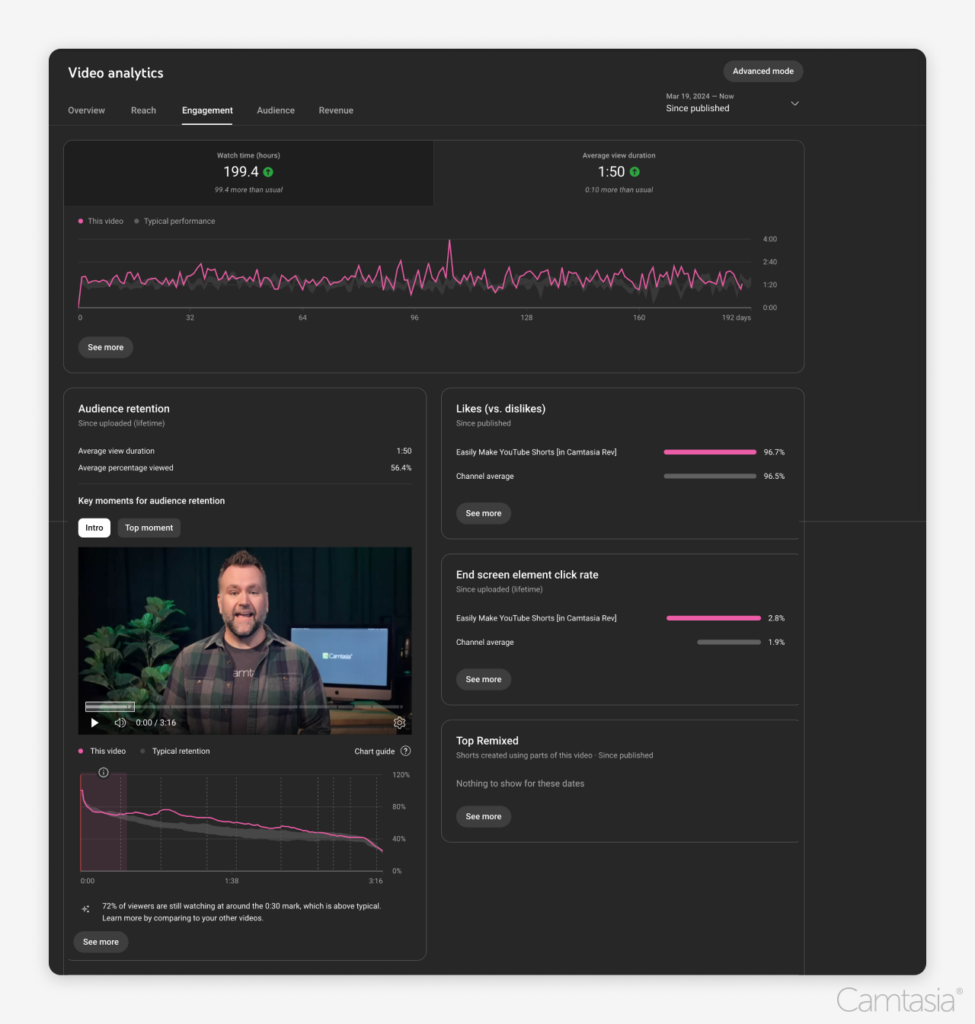
Viewer retention
Viewer retention shows you when viewers stop watching your video and if people have watched a portion of the video more than the rest.
Many YouTube videos experience a quick decline in viewership within the first few seconds. Pay attention to these trends in your videos. This initial drop-off often occurs because viewers decide the content isn’t what they’re looking for.
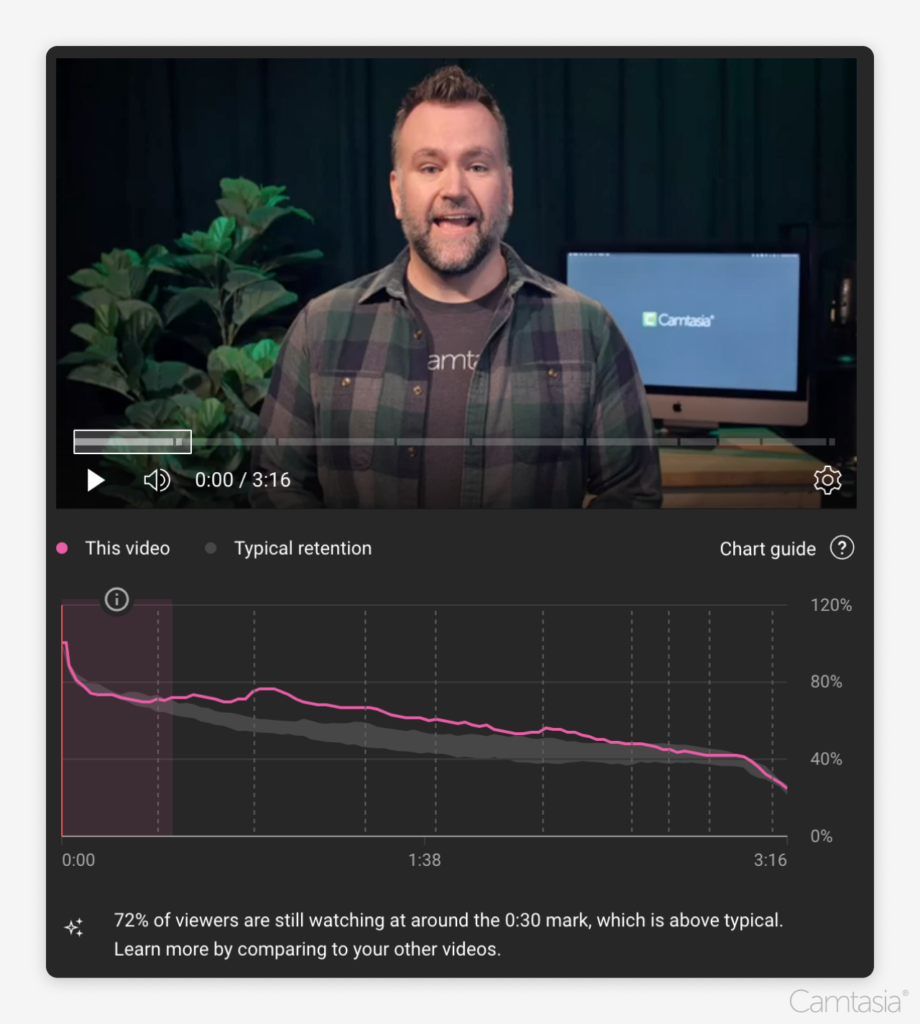
How do they decide this so quickly? It could be that the video doesn’t dive into the topic quickly enough, the audio or visuals are off-putting, or they get distracted.
To combat this, make the beginning of your video as engaging and captivating as possible—this is known as the hook.
A strong hook encourages viewers to keep watching. You might use an intriguing story, showcase the end result of a process upfront, or present something that directly connects with your audience’s interests.
Use viewer retention data to identify other points where viewers drop off. Analyze those moments to determine if any content might be causing viewers to leave, and consider making adjustments accordingly.
Engagement
Another important metric to watch is viewer engagement. Engagement is another signal to the algorithm that your content is worth sharing.
Engagement has several inputs, such as people liking (or disliking) your content and leaving comments.
You can’t manufacture engagement, but you can encourage people to like your content and leave comments on your video. You might ask them to answer a question that you ask during your video or encourage them to ask questions in the comments.
Encourage engagement through calls to action
As you look for ways to engage your videos, you can make several invitations. CTAs can take several forms. The invitations can come through the video, pop-ups on the video, or YouTube info cards.
Some of the common opportunities include asking viewers to click the like button, leave a comment, or to ‘hit the subscribe button’.
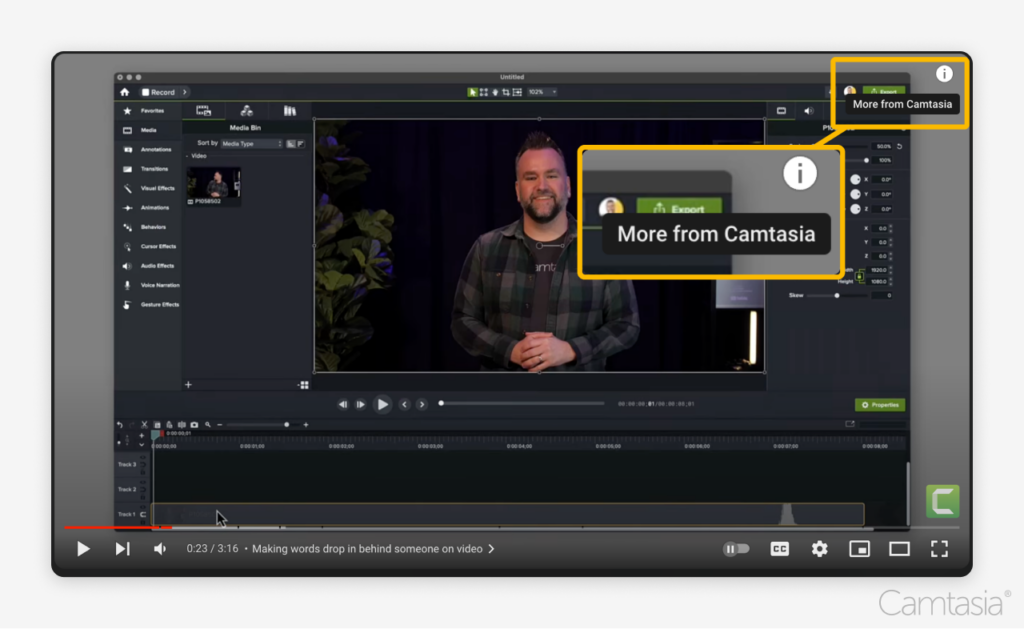
As you plan your video, find ways to incorporate the prompts organically and naturally. Inviting your viewers to take action at points in your video that won’t disrupt the flow.
In addition to stating or asking in your video, you can use your video editor, like Camtasia, to place visual prompts in your video. Camtasia allows you to easily add subscribe buttons, which can then be made clickable through YouTube’s editor.
With Camtasia templates and asset library, it’s easy to add these types of CTAs for all of your videos. These assets will speed up your creation and allow a consistent approach throughout your videos.
Stardom awaits!
Camtasia is the perfect way to create exciting content for YouTube, TikTok, Instagram, and more!
Free Download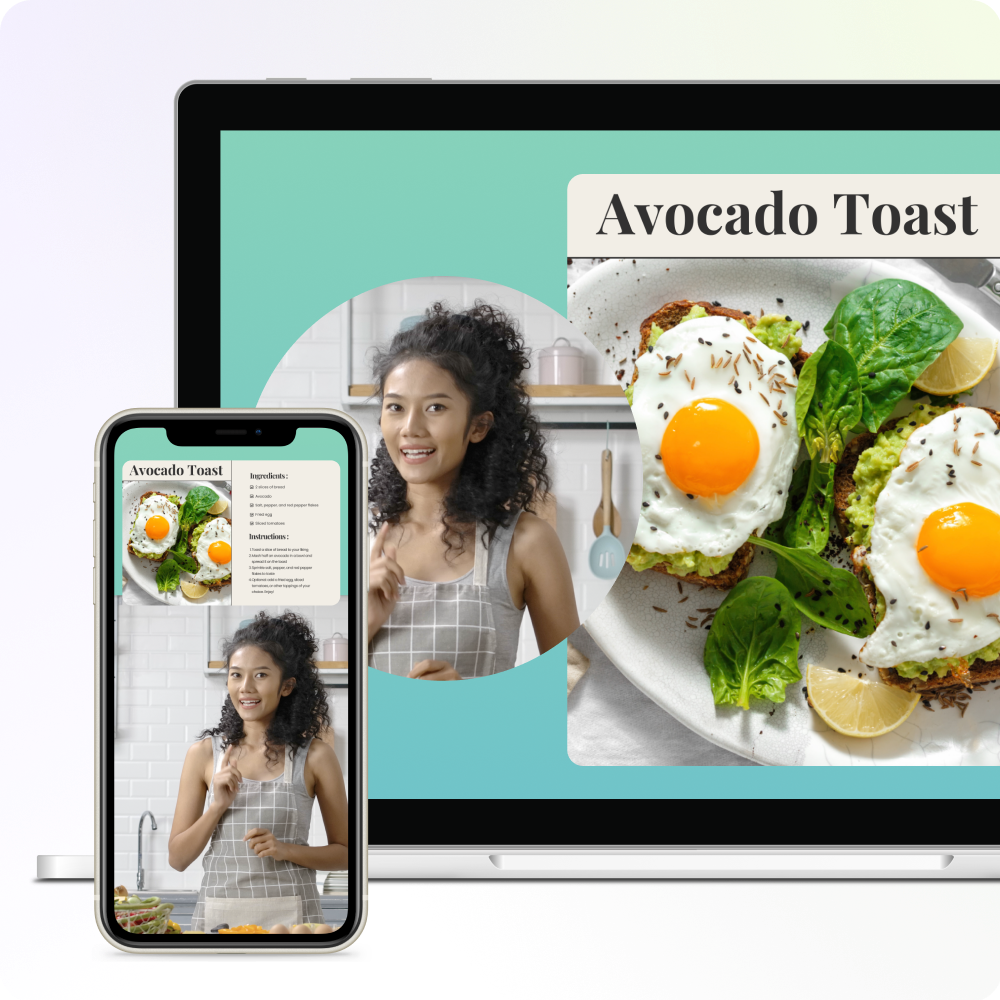
Promote your channel across platforms
As you look to grow your channel, look beyond YouTube. Connect with your audience where they are, including social media, your own site, and various communities and forums.
Share videos on social media and blogs
In marketing your content, there are platforms that you ’own’ and should be promoting your content on. One of these is social media platforms.
Each social media platform has its own unique focus. For instance, LinkedIn is oriented toward business professionals, while Instagram caters more to casual users.
Each platform will have different requirements. Some platforms allow you to share videos from YouTube directly, but many don’t.
When you can’t post your YouTube video, you may post part of it or create supporting content that points viewers on other platforms to your full video.
Another space you own is a blog. Blog posts are useful tools for sharing your message and content. They can also be natural places to embed your videos.
Embedding-related videos allow you to increase the SEO on that page, which can correlate with increased traffic and views. In addition, you can use content from your blog posts to further promote your video on social media.
Engage with communities and forums
Another opportunity to connect with your audience is by engaging in online communities, such as Reddit or topic-specific forums related to your niche.
As you enter these spaces, each will have specific promotion rules and guidelines. Pay attention and abide by their guidelines. Avoid spamming the community, including over-promotion and posting content or videos that don’t relate.
Being active and present in these communities can help people discover you and your content. As community members recognize your value, they will be more likely to take an interest in what you have to offer.
In addition to a promotion opportunity, both communities and forums are full of ideas for new video topics. Participants may be asking questions you can use to generate content ideas. You may also find conversations about topics that you have comments and thoughts on that would make for an interesting video.
Utilize YouTube Studio for analytics and growth
As you work to grow your subscribers on YouTube, pay close attention to the provided metrics. These will guide you and help you make informed decisions about what you should continue doing and what you should stop doing.
Track performance metrics in YouTube Studio
YouTube provides individual video and overall channel metrics. These both will give you insights into your channel’s performance. Take the time to learn how to use each metric and what it means for your content.
Your metrics will tell you if a video resonates with your audience. You can also see data such as where your viewers watched your content. Additionally, you can view other metrics like the search terms viewers used to find your content, the number of unique viewers, and the number of subscribers gained.
If you are serious about success on YouTube, learning to use YouTube Studio metrics is a must.
A/B testing and experimenting with content
As you get comfortable with the metrics and data in YouTube Studio, you can start optimizing your content.
For instance, YouTube has allowed most channels to use its Test & Compare feature. This test allows you to provide two to three different thumbnails for the same video, which YouTube will then test to see which one got the most people to watch.
There are various tools, including new ones being rolled out by YouTube, that can help you run comparisons for titles, descriptions, tags, or even videos. Split testing can be done manually but requires attention to detail and scrutiny of the data.
Monetize your YouTube channel with the YouTube Partner Program
Many creators are on YouTube, dreaming of making money for the content they create. It’s possible and can be done. It is helpful to temper your expectations, but with focus and determination, you’ll find yourself receiving your first payout.
Qualify for the YouTube Partner Program
To qualify for the YouTube partner program, you will need to meet the minimum requirements. These requirements are subject to change. Make sure you check with YouTube to ensure that you qualify.
As of publishing, creators need at least 1,000 subscribers with 4,000 or more valid public watch hours in the last 12 months. Or you’ll need 1,000 subscribers with 10 million valid public Shorts views in the last 90 days.
While a high bar, being part of the Partner Program will provide enrolled creators with monetization opportunities and resources.
Maximize revenue opportunities
The Partner program is not the only way to make money from your YouTube channel.
YouTube creators often try to monetize their efforts through programs like affiliate marketing. By placing links to products or services with tracking codes in the URL, the creator is credited for any sales that come through that link.
Remember, the Federal Trade Commission in the United States and governments in other parts of the world regulate rules on what must be disclosed, such as whether links will earn the creator a commission.
Another potential revenue stream is sponsorships. Sponsorships are a great way to promote a product through mentions or reviews.
Sponsorships are harder to obtain since they usually require a relationship with a company. Sponsor organizations determine their sponsorship through various metrics, including subscribers, engagement rates, and views per video.
While sponsorships offer many opportunities, they can also distract or disrupt your audience. If you take a sponsorship opportunity, it needs to fit with your audience. Too many sponsorships, or those that don’t align with your audience’s interests, can turn away viewers and subscribers.
Other revenue sources include selling merchandise, creating extra content for paid subscribers, mastermind sessions, and selling online or in-person courses.
Each revenue opportunity has pros and cons. Seek the ones that make the most sense for you and fit your goals.
Avoid common pitfalls in growing YouTube subscribers
Growing your channel subscribers can be challenging. If you’re not mindful, you can run into problems in several ways.
Don’t buy YouTube subscribers
You may be tempted to take a shortcut to grow your subscribers by buying subscribers.
Don’t do it.
In the short term, it will give the impression of growth. However, in reality, it will result in inactive accounts. It won’t increase the overall engagement, retention, or other metrics that matter.
In addition, accounts that are caught purchasing subscribers are in violation of YouTube’s terms of service.
Organic growth, while challenging, is far more sustainable. Focusing on those genuinely interested in your content can help increase your other metrics, leading to high-quality engagements.
Remember, YouTube is trying to serve content people want to watch. You will benefit from doing the same.
Avoid overloading videos with calls to action (CTAs)
Another pitfall is having too many calls to action in your video. Whether you’re asking people to click on the YouTube subscribe button, watch the next video, or visit your website, too many choices will turn viewers away.
You want viewers to take an action. The general rule of thumb is to focus on one primary CTA and one secondary CTA.
Each CTA should provide a clear benefit to the viewer, showing how it can help them or meet their needs. You can place the CTA in various spots throughout the video—there’s no one perfect answer.
However, when you do add a CTA, ensure it fits within the video’s context and doesn’t distract from what you are trying to say or show.
For example, your primary CTA may invite viewers to subscribe and click the bell icon to be notified of new videos. This could come after you’ve introduced or hooked your viewer. The secondary CTA could be to watch another video on a similar topic. Pace it at the end of the video or when the topic is mentioned in the current video.
Ultimately, there’s a delicate balance between creating content people want to watch and encouraging them to take action. Experiment and try different approaches to see what works for you.
Conclusion
The path to success on YouTube isn’t guaranteed. It takes hard work and dedication. However, you can find success by using skills like SEO optimization, understanding data, and promoting your channels.
On your YouTube journey, be consistent. Keep trying new approaches and techniques. Use tools that allow you to harness your creativity and abilities. Remember, tools like Camtasia are easy and powerful, allowing you to create effective and engaging content.
And remember, it takes time. Many successful YouTube Creators didn’t find success in a week, a month, or even a year. Many have worked at it year after year after year. And as you put forth the effort, you will find success too.
Make videos your viewers crave
Discover the secrets of what your viewers truly want in your training and instructional videos.
Get the Full Report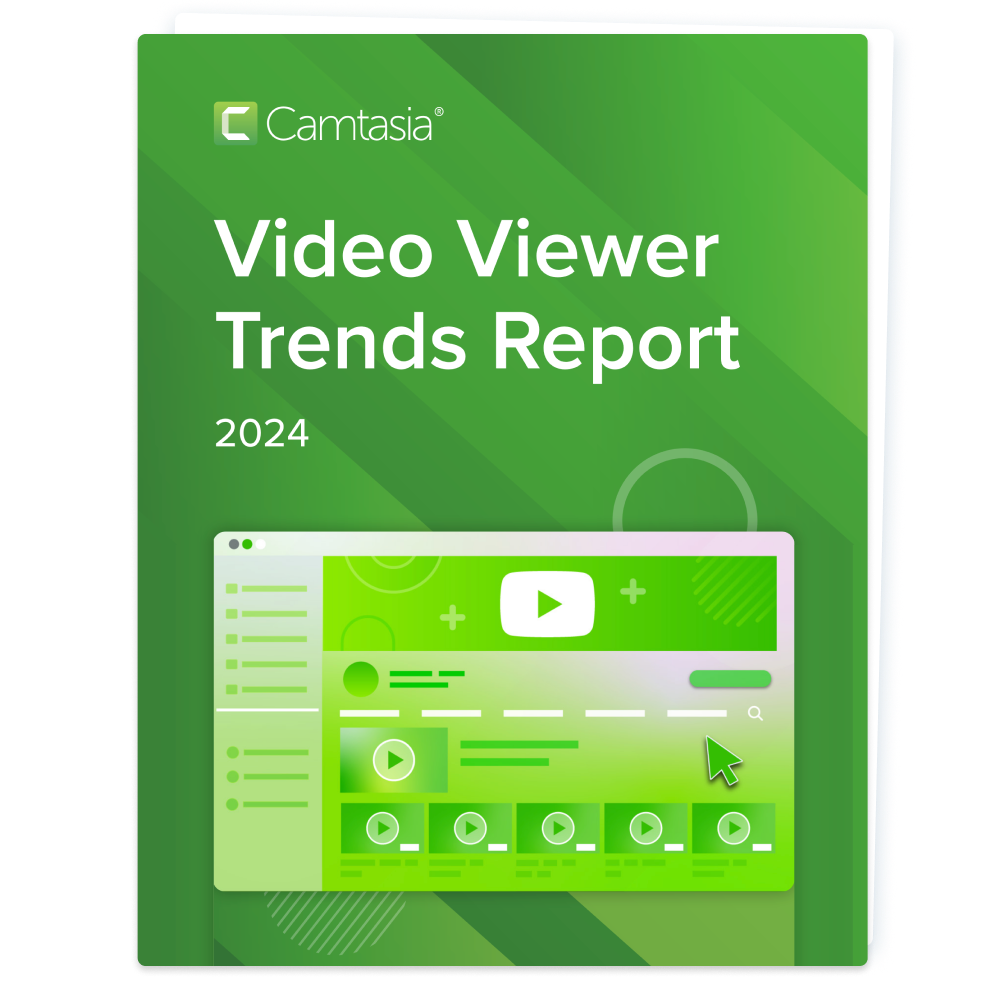



Share